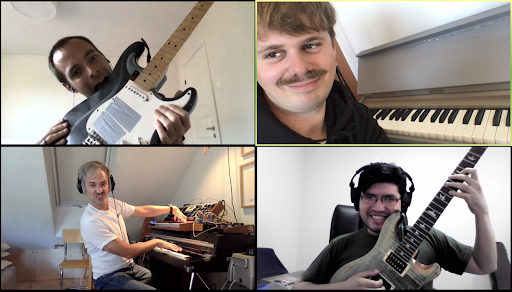Jamulus, or jamu-less?
Jamulus, or jamu-less?
Playing music together is not at all only about hearing, but also about the visual. Today the MCT students of 2020 experienced this in a “low latency jam session” in Jamulus. Short version of what Jamulus is: an online play-together program, that lets you join sessions with other musicians. You need to install Jamulus to your computer, and ideally use a cabled connection to the internet.
You can either join an existing server, or set up your own server if you like a more private jam-session. We all connected to a closed server located at NTNU in Trondheim, and total delay (latency) for those of us who are located in Norway was between 20 and 45 ms, which is decent, but also enough to make rhythmic and percussive music a little hard to play.

B-jam
In the B-team three of us are in Norway, and one in Ecuador, meaning that we needed to figure out what kind of music we thought would work. We decided to go for an easy chord progression, based on some droning tones in a patch from a Moog Voyager. The rest of the setup was an electric guitar, electric guitar tuned like a lute (a lute-caster!), and an old pump-organ. We used a drum-loop to hold it all together, and it kind of worked. Our music was very textural, and consisted more of soundscapes than melodies. The reason it kind of worked for us was primarily because the chords we used worked well with the same basic set of notes. It would be interesting to try it again with something more structural. Something with notes starting and ending at specific times. Maybe the outcome would be different then. It’s easier to get something to sound good when it doesn’t matter what chords and notes are being played where.
Sound
The quality of the sound is not recordable, and there were some clicks and pops, but it is possible to play together with ok quality, if you have ok bandwidth and you are not too far away from each other (and the server) geographically. We were experiencing a phonographic effect caused by sound quality. Reducing the quality makes it less “meaningful” to play together, as some of the fun is to hear the details in what your co-musicians are playing. The real challenge was to place yourself and your co-musicians in the mix. To keep the latency low, most people will use mono sound, and then the mixer doesn’t have options for panning when playing mono, making it feel a little like a wall of sound.
Audiovisual
The experience also made clear that playing together is not only about hearing – but also about seeing – each other. When jamming with other people, especially people you haven’t played with before and don’t know musically, seeing is essential. It might be another experience if we had tried a standard song everyone knew really well, but without being able to communicate visually while playing (we tried to use Zoom for this simultaneously and found it more confusing than no visuals at all), Jamulus and other services like it will remain good ideas that haven’t yet been successfully executed.
Jamulus Epilogue - Can’t Forget About Human Error
One week later…
In a follow-up Jamulus session, we had hoped to experiment with more rhythmically dynamic music. It had been helpful to lean on an ambient approach in our first Jamulus session, but we hoped to learn more about the specifics of our latency problems by pairing off in duos or trios with the fourth participant listening for latency details that are harder to hear when playing.
However, much to our surprise, Jamulus appeared during our second session to be performing much worse than it had previously. Latency was less consistent in its length, and one group member reported that the value for ‘Overall Delay’ on his end was ping-ponging back and forth between 20ms and over 200ms. It seemed that Jamulus was just not having a good day.
But wait! Right when we were about to blame Jamulus for everything, we realized the root of the problem was actually the dreaded human error. While attempting to use Jamulus the group was simultaneously uploading over .6 GB of audio files to a shared dropbox. Oops. Obviously we had found a very, very effective way to ensure that our Jamulus experience would suffer.
The moral of this story is nuanced. Is Jamulus perfect? No, issues of timing and visual experience that we detailed after our first session are valid problems that limited the satisfaction we found in using Jamulus. However, our second session proved just how important it is to optimize the conditions in which one is using Jamulus. The more that the human user can help Jamulus succeed by minimizing any other computing demands, the better Jamulus will be.
